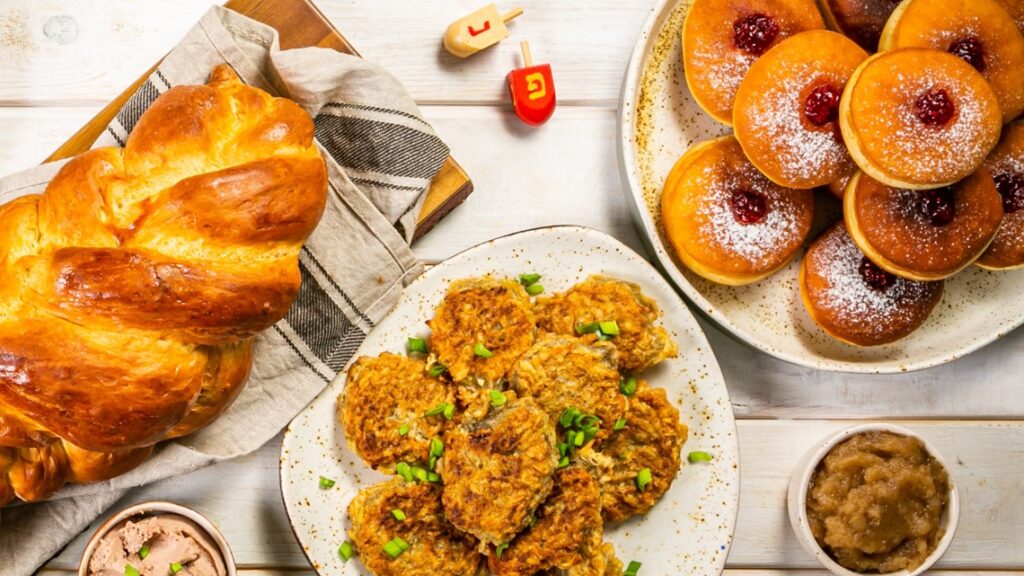Exploring the Top 6 Foods for Hanukkah In 2024

The Culinary Marvels of Hanukkah 2024: A Delectable Journey Embark on an authentic Hanukkah celebration, indulging in a curated array of traditional foods in an enchanting culinary journey. Made with deep appreciation, these delights offer solace and recall an ancient miracle, enriching the culinary experience. Against odds, the miraculous Hanukkah event let Jewish Maccabees light temple lamps for eight nights with oil meant for one. Foods for Hanukkah A Symphony of Gastronomic Wonders Discover the gastronomic marvels that define traditional Hanukkah fare. The comprehensive Hanukkah culinary repertoire presents an assortment of both savory and saccharine delicacies, served as petite indulgences and elaborate courses. The emphasis on fried edibles pays homage to the integral role of oil in the original miracle, creating a symphony of flavors that encapsulates the rich culinary journey of the Jewish people, seamlessly blending European traditions with age-old customs. Mastery in Formulating Traditional Hanukkah Foods/Culinary Delicacies Sufganiot: Embark on a delightful culinary odyssey with Sufganiot – classic jelly-filled pastries, plump and ethereal, adorned with a dusting of powdered sugar. These fried delights tantalize the taste buds, paying homage to the pivotal role of oil in the Hanukkah revelry. The crispy exterior yields to a burst of flavors, introducing a sweet, jelly-filled center. While fruit jelly remains a customary filling, those desiring a twist can indulge in the delightful alternative of sweet custard. The contrasting textures and rich, sweet notes make Sufganiot a cherished treat, intertwining tradition and innovation in the festive tapestry of Hanukkah delights. Kugel: Rooted in Central Europe, kugel emerges as a decadent sweet casserole, a symphony of egg noodles, sugar, eggs, and sour cream. Augmentations like raisins, cinnamon, and nutmeg elevate its richness, creating a dessert resonating with opulence. This indulgent culinary creation finds a special place among the favorite Hanukkah foods, becoming a vessel for encapsulating the cherished flavors of holiday recollections. Its intricate blend of ingredients and meticulous baking process contribute to its opulent nature, making kugel a beloved delicacy, adding a touch of nostalgia and festive delight to the Hanukkah celebration. Challah: Challah, a vital Jewish bread, symbolizes God-sent manna, sustaining wandering Jews during biblical journeys—a profound cultural emblem. On a Hanukkah table, it’s recognized for a crisp, brown exterior, an egg wash, and a substantial braided shape. The bread achieves a perfect balance of crunchiness and fluffiness, ideal for savoring succulent brisket juices. The artful combination of textures enhances the overall dining experience, as each bite encapsulates a rich tradition and adds a layer of gastronomic delight to the festive celebration. You might also be interested in… Persian Food 40Popular Culinary Dishes Brisket: A frequent star on the Jewish Hanukkah culinary stage, the succulent brisket takes center stage for its economical appeal. This meticulously prepared dish undergoes a transformation with a perfect blend of savory herbs such as thyme and sage, simmering in a wine-infused broth. Executed with finesse, the brisket becomes a tender, succulent centerpiece, promising to gratify even the most discerning palates. A festive feast highlight, its rich flavors and tender texture embody traditional Hanukkah culinary excellence. This culinary masterpiece, embraced with expertise, adds indulgence to the celebration, creating a memorable dining experience for all. Latkes: Crispy Potato Pancakes: Honoring temple lamps’ oil, Hanukkah’s standout: crisply fried potato pancakes, crafted with precision, grace the culinary celebration. Crafted from shredded potatoes and onions, akin to hash browns, these delights, topped with applesauce, are a delightful side dish. In crafting these pancakes, attention to detail mirrors the historical celebration, where oil played a crucial role. Symbolizing Hanukkah’s miracle, these pancakes blend tradition and flavor, embodying the festival’s essence on the festive table. Crispy outside, tender inside—a timeless culinary journey linking modern celebrations to their historical origins. Mandelbrot: Mandelbrot, resembling Italian biscotti, aligns with kosher laws by omitting butter or milk. Various ingredients produce a long, crisp cookie filled with almonds, chocolate chips, or dried fruits. Baked twice, it attains the characteristic crunchy exterior. An exceptional Hanukkah delight, Mandelbrot serves as a delightful post-dinner pairing with coffee or tea. Its intricate preparation adds to the festive atmosphere, offering a sweet conclusion to the celebratory meal. Mandelbrot, a delicious addition to Hanukkah traditions, symbolizes joy with rich textures and flavors in the culinary journey. You might also be interested in… Arabic Food 10 Dishes and 7 Culinary insights Embarking on a Culinary Odyssey The prospect of orchestrating an authentic Hanukkah feast may seem somewhat daunting, particularly for those unacquainted with these epicurean offerings. If venturing into this culinary odyssey alone appears formidable, consider enlisting the expertise of a world-class chef. Explore cooking classes in Dallas, Boston, and nationwide for insights into crafting traditional Hanukkah delights. Finding nearby cooking classes and private chefs ensures your festive meal reaches perfection, enhancing your Hanukkah celebration. Explore virtual culinary mastery with online holiday cooking classes, bringing expertise to your home kitchen for a festive experience. For an adventurous spirit eager to explore the menu, these ten Hanukkah dishes offer a robust culinary initiation. These delights, rich in history, elevate your table and immerse you in Hanukkah traditions’ vibrant tapestry. In conclusion, let the culinary odyssey of Hanukkah 2024 be a celebration of flavors, traditions, and the enduring spirit of festivity. May each bite be a tribute to the ancient miracle and a testament to the rich cultural heritage that defines the Hanukkah experience?
